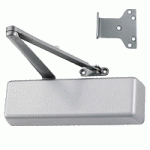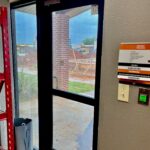 ESE stands for Exceptional Student Education and refers to specially designed instruction and related services at school for children with disabilities. One common difficulty regarding the doors in ESE classrooms as well as classrooms for very young children, is the possibility that a student will leave the classroom through an exterior door and end up in a dangerous situation.
ESE stands for Exceptional Student Education and refers to specially designed instruction and related services at school for children with disabilities. One common difficulty regarding the doors in ESE classrooms as well as classrooms for very young children, is the possibility that a student will leave the classroom through an exterior door and end up in a dangerous situation.
The available code-compliant options to discourage the use of these doors are:
- Add an exit alarm which will sound if someone attempts to use the door.
- Adjust the spring power of the door closer to require more opening force without exceeding the opening force limitations of the adopted code. This option may not be effective for older students.
- Install a delayed egress lock that will delay a student from exiting for 15 seconds (or 30 seconds where approved by the AHJ) while sounding an audible alarm. This is allowed by the 2018 and 2021 editions of the IBC for classrooms with an occupant load of less than 50 people.
- Enclose the area outside of the exterior door with a fence that would limit the student’s travel. Keep in mind that the enclosed area would have to be large enough to provide a safe dispersal area, or would require an egress gate or approval from the AHJ.
I was recently contacted by a code official for a school district, who asked if something like what is shown in the image would be acceptable as a means to slow students down when they attempt to use the exterior door. The area within the queue would have to be large enough to allow wheelchair passage, and the size of the queue would be limited so that it does not affect the use of the room.
Do you think the queue is a viable option for slowing students’ access to the exterior door in an ESE or preschool classroom?
If yes, how would you construct the “walls” of the queue?
What concerns do you have regarding this idea?
WWYD?
You need to login or register to bookmark/favorite this content.







As a parent, parent of a child with disabilities, person with a teaching license, and a hardware professional, I have a lot of opinions on this.
First, I think we need to end the use of euphemisms in both education and in life safety discussions. The children who are served in these classrooms have disabilities. They wouldn’t be in that situation if they didn’t have disabilities as the law requires they receive a free appropriate public education (FAPE). When we use euphemisms in education we minimize the need for accommodations. When we use euphemisms outside of education, we confuse people and lead to an unnecessary waste of time asking for more information.
Second, because we poorly accommodate children with disabilities in education (and child care) settings, we have far more concern for elopement than if we were providing proper accommodations and developmentally appropriate opportunities. If the subject of disability in education settings is not personal to you, there’s never a bad time to get educated. Special education funding is a huge issue.
Finally, as for the door hardware. Given the options in the article, I’d go with an outside, fenced yard as a buffer as my #1. I’d include egress as required by the local authority, but I think something like a pool gate lock might be approved. If that wasn’t feasible, I’d recommend delayed egress with a push bar or exit device activation and a separate immediate override button mounted up high where only teachers could access it.
As for the queue, I have some concerns. Could a child hide within the queue, behind a wall? Is the queue treating one problem, but creating multiple, more expensive issues? The space and funding for special education classrooms is already severely limited in most schools. Taking away room and funding for possible OT equipment and its use seems to be counterproductive. I think an outside yard buffer might actually provide more space for programming while providing a solution to the issue. If funding and space were not an issue, I’d look at that first.
Hi Joe –
Thank you so much for sharing your insight!
– Lori
Addressing the “Could a child hide within the queue, behind a wall?”: That is an excellent observation/concern! Maybe if the queue was set up like a queue in a bank, as people approach the teller? jmho 🙂
Looking forward to the responses on this one as I have been dealing with this for years. There is NO solution. Eventually a barrel bolt, flippy lock, child proofing the lever/knob or some other magic will be installed when you’re not looking. I do like the delayed egress approach but 15 seconds can be an eternity and an illegal work around will fix that annoyance? Alarms are cool but many of the children in these classrooms have a severe sensitivity to noise. The mouse maze approach simply gives the kids a bigger head start and more places to disappear. A watchful eye from the instructors is the only thing to prevent “runners”, but with all the activity involved in these rooms, that is very hard to do. I’m not being negative, it’s the reality of the situation.
Bruce, My I ask what State you’re in? Do you work for a K-12 system? I’m nosey. LOL
In case Bruce doesn’t see your question, he’s with a school district in California.
– Lori
Is the exterior door a necessity? If not I would block it up. Is a student leaving through the exterior door any less dangerous then leaving through the classroom entry door? I think the queue could cause a visibility issue for the teacher. Other than the fenced in area outside I can think of no other remedies for this situation.
I wonder if the school official has spoken with the teachers and aides who work in the room. “Normal” classrooms are often tight for space, and for ESE classrooms, while there may be fewer students, the floor area that wheelchairs take up means the queue maze would take up space that could otherwise be used for instruction.
Walls should be short.
Door alarm would be simpler, in my opinion.
The delayed egress alarm sounds like the best. This was what we used for our Alzheimer’s unit in the skilled nursing facility. We also had a keypad with a 4 digit code that would open the lock for a few seconds to allow staff to exit without tripping the alarm. The patient’s were unable to figure the keypad out, at least.they never did in the 3 years it was in operation. Otherwise the delayed release door worked as required. As I recall the code at the time required the door to remain unlocker until manually reset to prevent a “train” of people needing egress suffering a delay after each actuation. This was a problem only in that it required a staff response in time to look and evaluate who was leaving.
Is the queue space now circulation or usable space in calculating room square footage for occupancy?
In situations where space needs are premium this maybe waste of space. My preference is another option such as delayed egress lock.
I do not see an issue, as long as, minimum code width is maintained, wheelchair turnaround width maintained, and other ADA concerns. This is similar to a queue at a theme park. I cannot quote a code violation.
Not an answer to your exact question, but related; In doing exit doors for Head-Start classrooms in non-school buildings here were a couple of solutions.
1. as mentioned a. crank up the opening force on the door closer, b. Exit alarm, or c. delayed egress, all can work.
Additionally-
2. For young students (pre-K, K,1-3rd grade) mount exit hardware or auto operator buttons at 48″ height. For small students it can be just out of reach, and/ or with an allowable max of 15lbs of opening force per 1010.1.10.1, making it hard to open.
3. It may also be possible to discuss a change in occupancy with the AHJ to I-2 per 1010.1.9.7 for those “in need or requiring confinement”.
The last 2 options per CA Fire and Building code.
Thanks Glenn!
– Lori
Hi Lori. My guess is that the exterior door is a required means of egress?? Given the nature of the space, I would think that a controlled egress door maybe using a……gulp!! magnetic lock would pass muster. An emergency door unlock and a button carried by the teacher may also be in order. Here is a word that may not be in most of our vocabularies … variance! Seems to me that this meets the intent of this word. Another idea. Make the maze from short glass partitions. Install a simple gate with an alarm. or flashing light (whatever). When the first gate is violated, the teacher can intercept the person before the kid reaches the door by using the teacher gate (which is locked in the egress direction. Relocating the teacher’s desk near the door is also possible.
Hi Jim –
I have seen something like a controlled egress lock (allowed in health care) used in education with a code modification, but these variances can be inconsistent and time consuming. Hopefully someday the model codes will have a solution that works well for these classrooms and does not require a variance.
– Lori
I observed a similar arrangement a while back that was constructed with low walls with a gate on the classroom side, similar to a “stairwell interrupter”, with a switch. When the gate was opened a recording would begin playing a voice prompt made in the teachers voice so it would be recognized by and familiar to the students.
Have you mentioned to the code official what appears to be a small room located within the adjacent stairwell?
Hi Larry –
The gate is an interesting idea…I’d love to see a video of this application.
The image was from another floor plan – not the same school.
– Lori